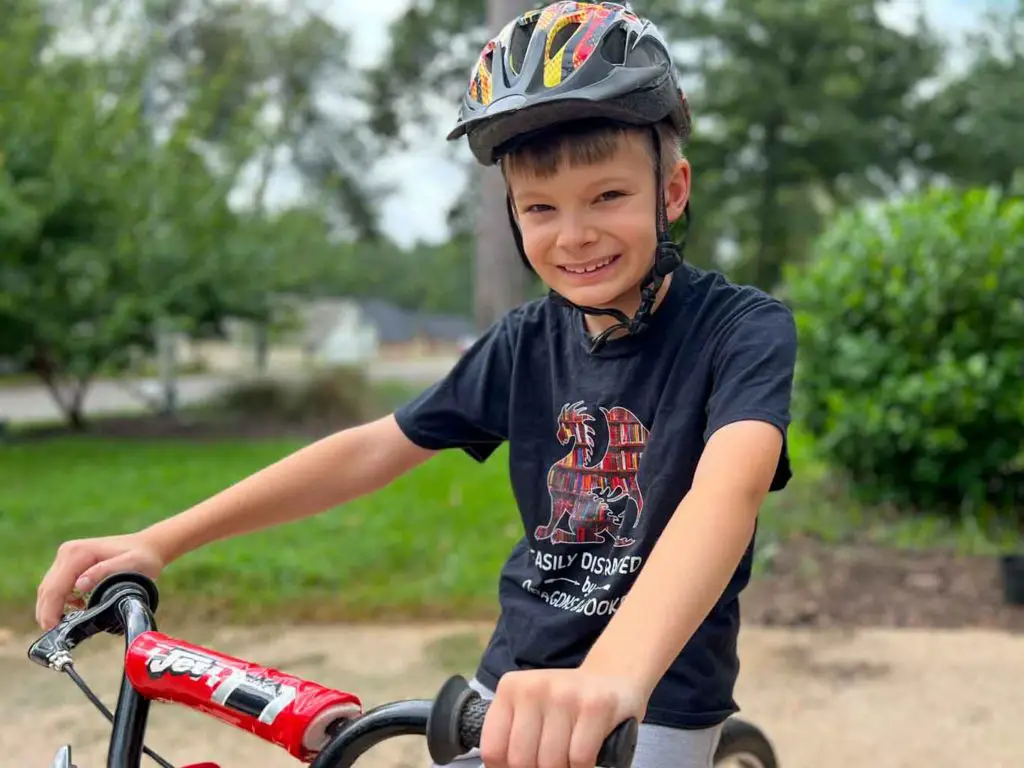
Kids can learn to ride bike at any age. Personally, I was a late bloomer. As much as my older brother tried to teach me to ride a bike, I just struggled. I still have the memory of him pushing me on my bike in our backyard and me crashing into a tree.
Now that I’m a dad, I realize I’ve passed my bike riding struggles down to my oldest son. And since I can’t remember exactly how I eventually did learn to ride a bike, I did what everyone else does, and Googled it.
Most kids learn to ride a bike between 2 and 8 years old. There are many great resources to help young kids to ride a bike, but what if my child is older? Is there a difference in how you learn to ride a bike if you’re older?
The basic principles of learning to ride a bike are the same regardless of age. To ride a bike you must learn to balance, steer, and pedal, in that order. The difference is, an older bike rider may need more steps than a younger one because of differences in maturity and size.
Let’s take a look at the differences between younger and older beginner bike rides. Then we will explore each step of the process to see just how easily you can teach your older beginner to ride a bike.
Difference Between Younger and Older Beginner Bike Riders
While the process of learning to ride a bike is essentially the same regardless of age, there are some differences to consider. The two biggest differences between older and younger beginner bike riders are psychological and physical.
A younger child’s brain is more elastic and can learn more quickly and often independently through immersion. Many studies have shown that young children can learn up to three languages without mixing them up. It also means really young kids can learn to navigate a balance bike with minimal teaching.

Brain plasticity is greater at younger ages, but that does not mean your child does cannot learn to ride a bike once they’re past a certain age. All it means is that they may need to encounter a task from different angles or more gradually. (This is not even getting into potential past experiences your child may have encountered that may interfere with their desire to ride a bike. But I’m not a psychologist and this is making my head hurt.)
The other big difference is that your child is bigger than they were at 4 (I know, I’m so smart). The implications of this is that their center of gravity is going to be very different than a 3 year old learning to ride on a balance bike with a really low center of gravity. Learning to balance may take a little more effort for an older child.
To complicate matters, your child is growing and still learning how their body works. I’m sure you can remember bumping into furniture all the time as a kid when you just had a growth spurt. Your child is likely still learning to make sense of the longer limbs they now have.
Setting Up a Bike to Learn to Balance
The first thing we’re going to do is turn your child’s pedal bike into a temporary pedal bike. There are three things you need to do to make a temporary balance bike. The first is to ditch the training wheels (check out 10 Reasons to NOT Use Training Wheels if you want to know why), lower the seat height, and remove the pedals.
A good rule for a beginner bike seat height is to set it up at or just below your child’s inseam. If you don’t feel like pulling out the measuring tape, lower the seat so your child can sit with his/her feet flat on the ground with their knees slightly bent. (for a more complete article on seat height, check out Best Bike Seat Height for Kids)
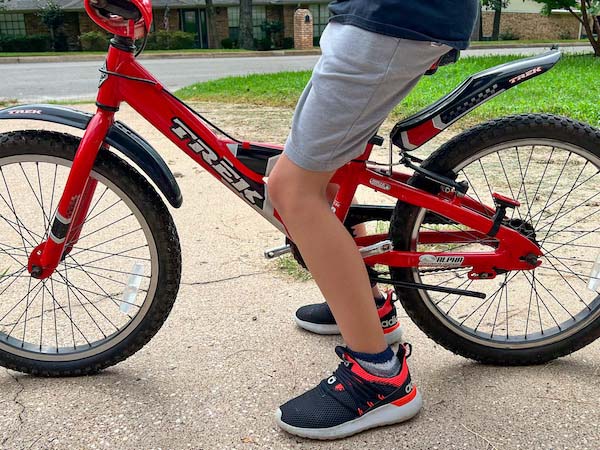
The next step is to remove the pedals. Make sure to mark which pedal is on the left or right side of the bike using some masking take. Use an adjustable wrench to unscrew the pedals. Remember that the pedal on the left side of the bike is backwards and unscrews in a clockwise direction. (That means the pedal on the left unscrews “righty-loosey”).
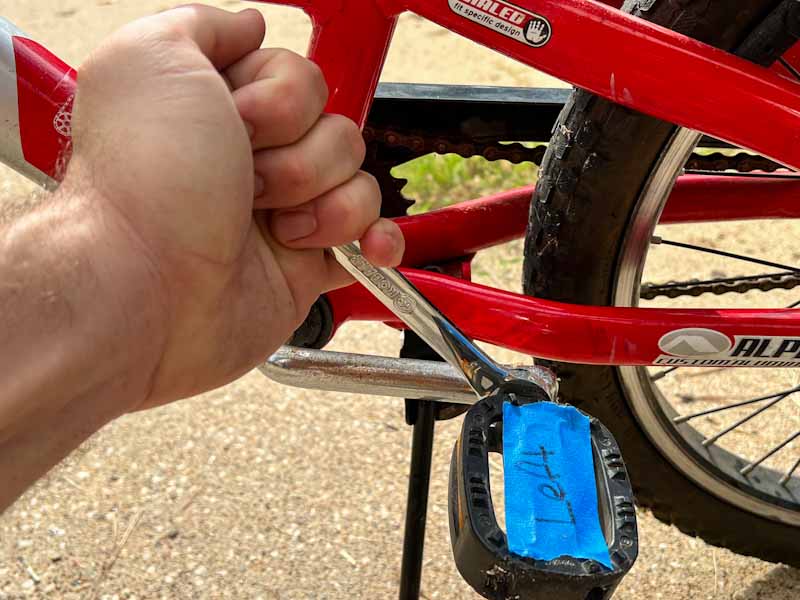
Best Place to Learn to Ride a Bike
Next you need to scout out a location. While you might think riding on the grass is a good idea, it really isn’t. Yes, it’s softer than pavement and will scrape you up less if you crash. The problem is that the ground is so uneven it creates resistance. Your child will struggle to gain the momentum needed to learn to balance.
An open, flat, paved surface is best. This might be your driveway, the road in front of your house, or a nearby parking lot. Something with a very slight slope is best. When your child begins to learn to glide, it’s nice to have gravity to help them gain momentum.
Teaching and Older Child to Balance on a Bike
The first (and most difficult) step for anyone to learn to ride a bike is learning to balance. The important thing to remember is to be patient with this step. Different kids learn at different paces. Some might pick this up right away, and some might take a while.
First, have your child sit on the bike seat and walk with the bike. Take your time and let your child get familiar with the feel of moving around with the bike.
Once they start to feel comfortable, have them take short bunny hops. Bunny hops are where you push off with both feet at the same time. Your child will then start to glide, even if only for a very short amount of time. When they feel good with short bunny hops, have them take bigger hops with longer glides.
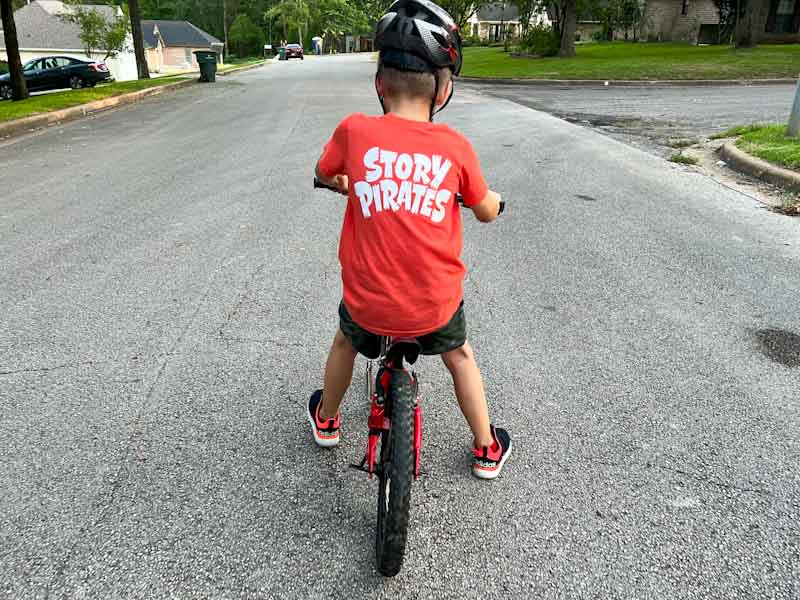
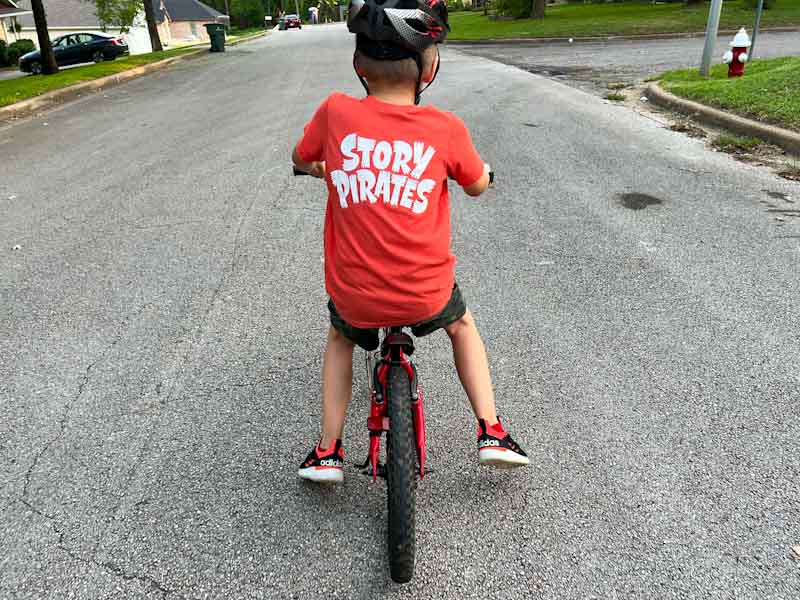
The next step is to go down a gentle slope. Let gravity do the work and challenge your child to see how long they can glide without putting their feet down. You might be able to accomplish all of this in one day, or it might take longer. Follow the pace your child needs and be patient and encouraging.
“Left, Right, Balance” Game
If they’re still struggling to get past walking or if they’re reluctant to try to glide down the slope, they may just need a couple more steps to get them there. A simple thing I did with my own kids (who were both reluctant to ride), is something I call “Left, Right, Balance.”
Begin by standing in front of the bike. Hold the front wheel between your legs and hold the handle bars with your hands. Have your child sit on the seat and lift their legs off the ground. When they can balance with their feet off the ground, take a step to the left or right. Have your child put their foot down to catch themself.

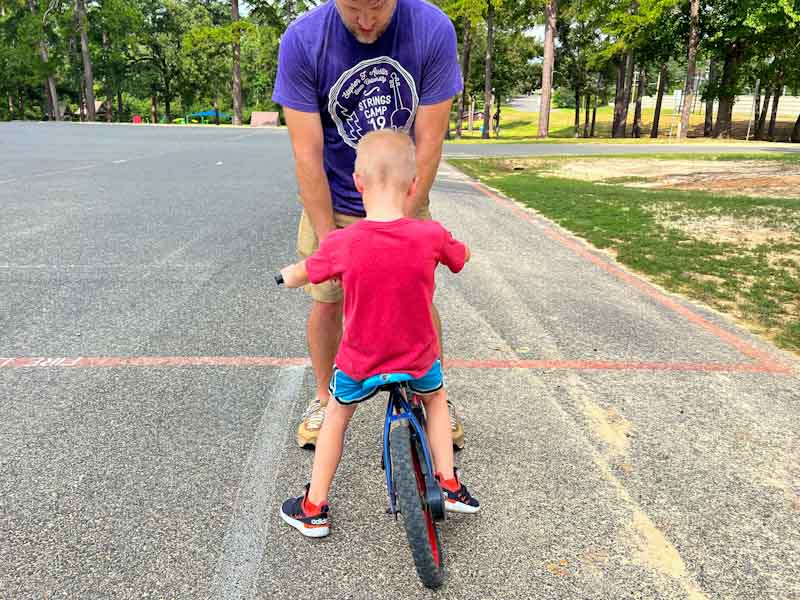
Do this for a couple of minutes going to the left and right. When they feel comfortable with this, then let go and take a step back. Let them see how long they can balance before they have to put a foot down.
This little activity helps your child to feel what it’s like to balance and how to catch themself. It can work as a nice break if they’re tired of walking around with a bike. In the end, it will help them to feel what it’s like to balance. I like to alternate this activity with going down a gentle slope because it serves as a bit of a warm up to gliding down a hill.
If you find that your child is still struggling, don’t get frustrated. They can absolutely learn to do this but need more time and practice. Keep following the steps every day or so and in time they will learn to balance. Don’t try to push ahead and put the pedals on. The best thing you can do is be patient and not get frustrated with them.
Teaching an Older Child to Steer a Bike
The good part about learning steering is that a lot of it is happening while your child is working on balance. As they learn to glide down that gentle slope, have them practice gently turning to the left or right. Most likely, they will learn how to steer intuitively as they work on balance.
If your child is struggling to turn, then it’s time to step in a do a little teaching. The first thing to remember is that you turn on a bike mostly by leaning, not turning the handle bar. (This is one of the reasons training wheels are not a good idea. If you want to know why, check out my article here.)
To help your child to learn to turn, follow behind them as they glide and hold them under their arms (not the seat or the handle bars). Gently hold their body and help them to feel how to lean into the turn.
Since your child is older, though, it might be a little harder to hold them. Grab an old bed sheet or large beach towel. Wrap it around their chest and under their arms with the ends of the sheet together in the back. Give the sheet a twist and hold on to this as you help them feel what it’s like to turn.
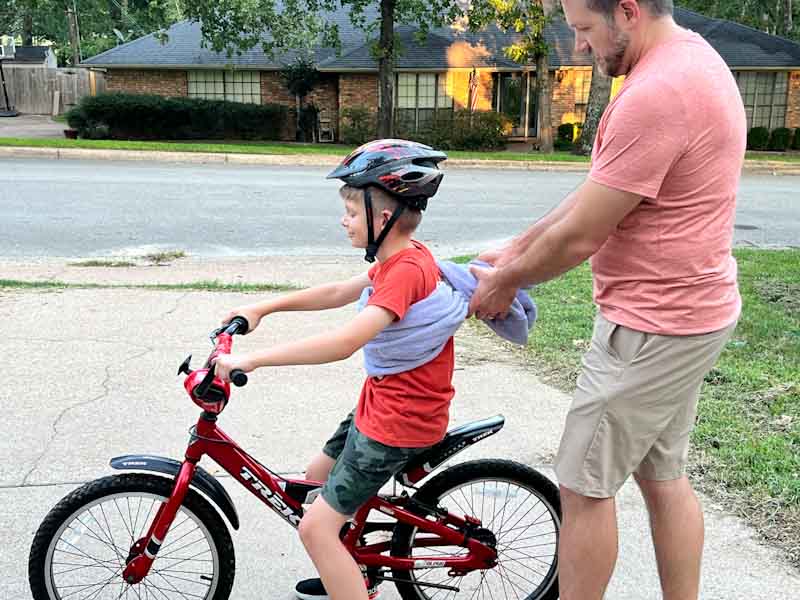
Teaching an Older Child to Pedal
Once your child feels good enough to balance the bike for a long glide, it’s time to put the pedals on and readjust the seat. Remember that when you put the pedals on that the pedal on the left screws in backwards (think “lefty-tighty”).
The height of the seat should sit right around your child’s inseam (a little higher than it was before). With your child seated on the bike, they should be able to put the balls of their feet comfortably on the ground with a little bend in their knees. Having a higher seat will make pedaling easier but your child will still need to be able to catch him or herself easily.
Begin by having either the right pedal in the 2 o’clock position, or the left pedal in the 10 o’clock position. It doesn’t matter which one. Place one foot on that pedal while the other foot is on the ground.
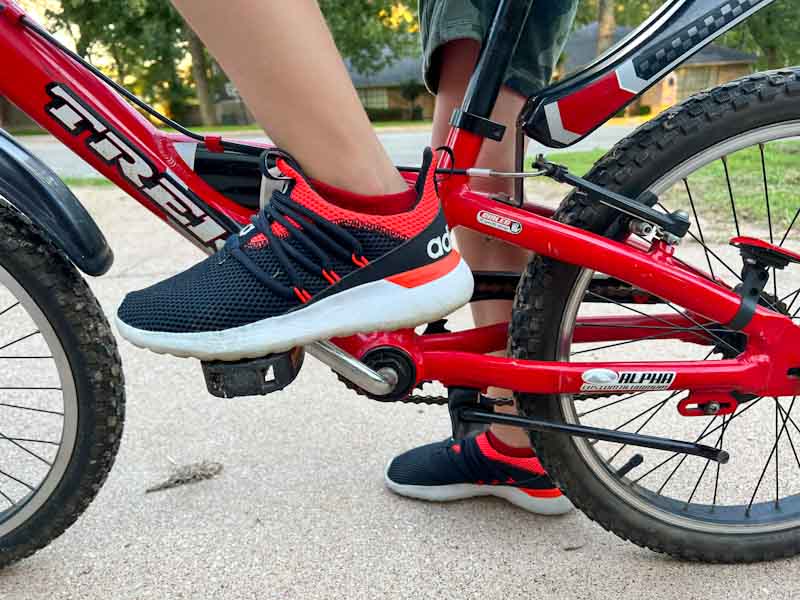
Now for the tricky part. Have your child first push down on the pedal, and then push off with the foot on the ground. Some beginners like to lift their foot off the ground first (and then lose their balance). The key is to get moving before you lift your foot off the ground.
All of this should happen while you hold either the back of the seat (don’t grab the handle bars) or under your child’s arms (a bedsheet or towel also works here too). Help your child gain some momentum and once your child feels weightless, let go.
Tips if Your Child is Struggling to Ride a Pedal Bike
It’s not uncommon for some children to struggle going from gliding to pedaling in one go. If you find your child is still struggling to learn to pedal, do the “Left, Right, Balance” activity a couple times. This will give your child a chance to feel what it’s like to balance with their feet on the pedals.
Another trick is to have your child put one foot on a pedal (in the 6 o’clock position) and use the other foot to push the bike forward and glide. Take the time to alternate feet and get used to doing this on both sides.
Recognize that your child might need a little more time and a couple of extra steps to learn to ride a bike. We all learn differently and at different paces. It is important to stay encouraging and be patient. You want bike riding to be a positive experience for your kids, not something they talk about in therapy in 10 years.
Recent Posts
I have a confession to make; I did a terrible job getting my kids’ first bikes. I had no idea what to look for and quickly settled for the free hand-me-down. Who’s going to turn down a perfectly...
I can hear it happening already. (Me using my best impression of my dad’s voice): “In my day, riding a bike was different.” And while I might weep a little as I slowly turn into a grumpy old...
